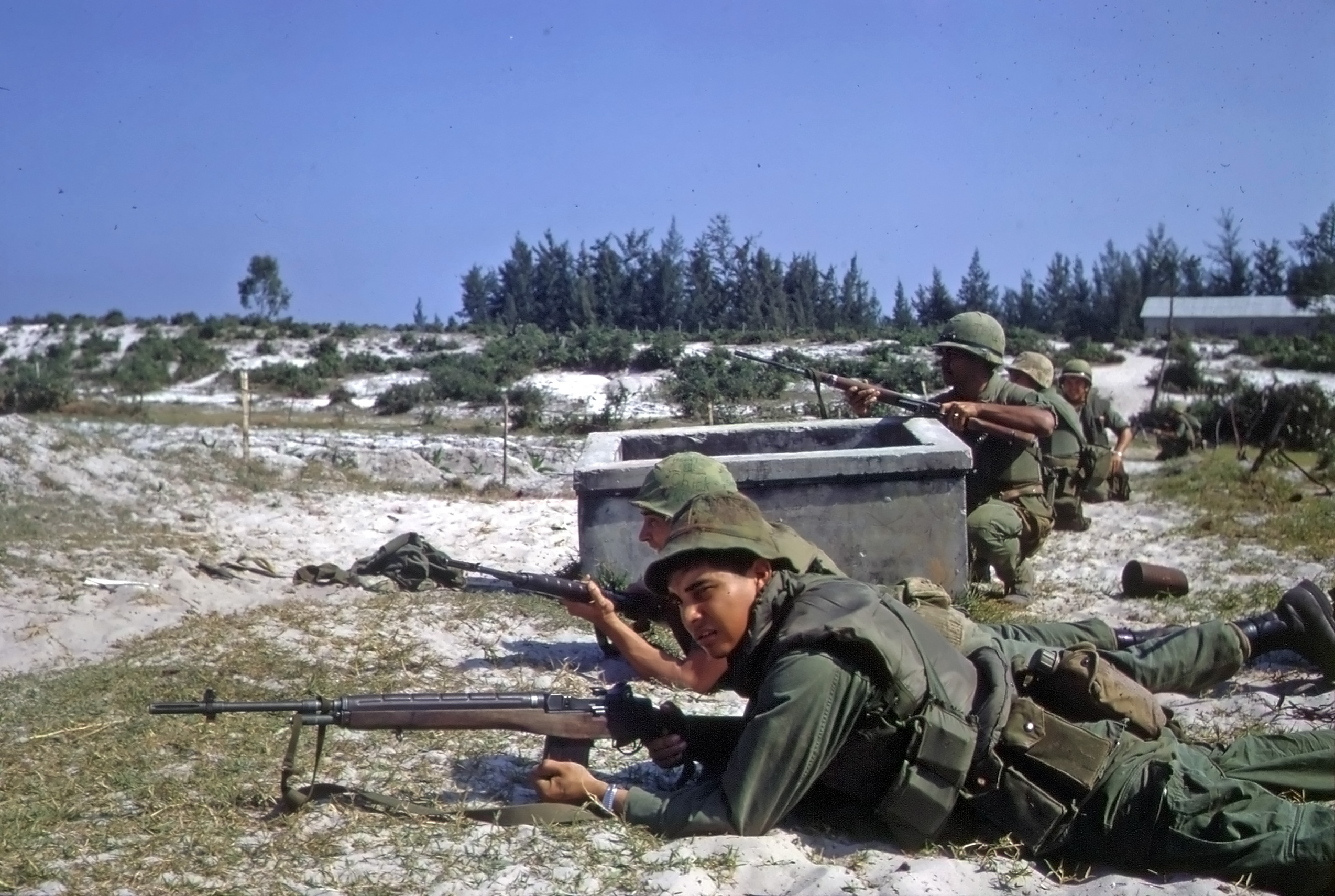|
2nd Division (Vietnam)
The 2nd Infantry Division also known as Quảng Đà Division or Steel Division is a division of the People's Army of Vietnam (PAVN), first formed from Viet Cong (VC) and PAVN units in October 1965. The first commander and the first commissar of the division were Colonel Nguyễn Năng and Senior Colonel Nguyễn Minh Đức respectively. In Vietnam War The Division was formed on 20 October 1965 from the 1st ( Ba Gia) Regiment and the 21st Regiment which had just arrived from North Vietnam. The Division was under the command of the PAVN B1 Front. In mid-1966 the newly-arrived 31st Regiment was added to the Division. In February 1967 the Division's 21st Regiment was engaged by South Korean forces, losing over 1,000 killed in 2 separate battles northwest of Quảng Ngãi. From 21 April to 5 June 1967, the Division was the target of US Marine Corps' Operations Union and Union II in the Quế Sơn Valley losing over 1,400 killed. In early August 1967 the Division's 1st and 2 ... [...More Info...] [...Related Items...] OR: [Wikipedia] [Google] [Baidu] |
People's Army Of Vietnam
The People's Army of Vietnam (PAVN; vi, Quân đội nhân dân Việt Nam, QĐNDVN), also recognized as the Vietnam People's Army (VPA) or the Vietnamese Army (), is the military force of the Vietnam, Socialist Republic of Vietnam and the armed wing of the ruling Communist Party of Vietnam. The PAVN is a part of the Vietnam People's Armed Forces and includes: Ground Force, Vietnam People's Navy, Navy, Vietnam People's Air Force, Air Force, Vietnam Border Guard, Border Guard and Vietnam Coast Guard, Coast Guard. However, Vietnam does not have a separate Ground Force or Army branch. All ground troops, army corps, military districts and specialised arms belong to the Ministry of Defence (Vietnam), Ministry of Defence, directly under the command of the Central Military Commission (Vietnam), Central Military Commission, the Minister of Defence (Vietnam), Minister of Defence, and the General Staff of the Vietnam People's Army. The military flag of the PAVN is the flag of the Socia ... [...More Info...] [...Related Items...] OR: [Wikipedia] [Google] [Baidu] |
Firebase Ross
Firebase Ross (also known as Hill 51) was a U.S. Marine Corps, Army and Army of the Republic of Vietnam (ARVN) fire support base located in the Quế Sơn District, Quế Sơn Valley southwest of Hội An, Quảng Nam Province in central Vietnam. History The base was located in the Quế Sơn Valley along Route 535, approximately 27 km southwest of Hội An. In January 1968 the 3rd Brigade Combat Team, 1st Cavalry Division, 3rd Brigade, 1st Cavalry Division had its headquarters at Ross. On the afternoon of 2 January, elements of the 12th Cavalry Regiment engaged a unit from the People's Army of Vietnam (PAVN) 2nd Division (Vietnam), 2nd Division in a four-hour-long battle 5 km south of Ross resulting in 3 U.S. and 39 PAVN killed. On the early morning of 3 January the PAVN attacked four U.S. firebases in the Quế Sơn Valley, launching ground attacks against Ross and Landing Zone Leslie, which were defeated by dawn for the loss of 18 U.S. and 331 PAVN killed. In late Jun ... [...More Info...] [...Related Items...] OR: [Wikipedia] [Google] [Baidu] |
Operation Pocahontas Forest
Operation Pocahontas Forest was a security operation conducted during the Vietnam War by the U.S. Americal Division and the Army of the Republic of Vietnam (ARVN) 2nd Division in the Quế Sơn Valley, South Vietnam from 6 to 31 July 1968. Background At the beginning of July, Allied intelligence indicated that the People's Army of Vietnam (PAVN) 1st Regiment, 2nd Division was operating near Hiệp Đức at the western end of the Quế Sơn Valley. General William B. Rosson ordered Major General Charles M. Gettys, commander of the Americal Division to secure the area. Operation Operation Pocahontas Forest was launched on 6 July to search for the 1st Regiment and preempt a possible attack on Hiệp Đức. MG Gettys formed a brigade-size task force under the command of his deputy Division commander BG Howard H. Cooksey. ''Task Force Cooksey'' comprised the 4th Battalion, 3rd Infantry Regiment, the 4th Battalion, 21st Infantry Regiment, the 4th Battalion, 31st Infantry Reg ... [...More Info...] [...Related Items...] OR: [Wikipedia] [Google] [Baidu] |
Battle Of Kham Duc
The Battle of Kham Duc was a major battle of the Vietnam War. The event occurred in Khâm Đức, now district capital of Khâm Đức District, then in Quảng Tín Province (now part of Quảng Nam Province, Vietnam), from 10–12 May 1968. During the Tet Offensive of 1968, the People's Army of Vietnam (PAVN) 2nd Division tried to capture Đà Nẵng, but they were defeated in the Battle of Lo Giang by elements of the U.S. 1st Marine Division and the 23rd Infantry Division (Americal Division). PAVN General Chu Huy Mân disengaged from the fight on the outskirts of the city, and pulled the 2nd Division into the mountains to rest, rebuild, and prepare for the next major operation. The US and allied defenders of the Special Forces camp at Khâm Đức, a small district in the north of Quảng Tín, were chosen as the next target for the 2nd Division. Although the Special Forces camp had never been an obstacle to the constant infiltration of PAVN troops around it, the North V ... [...More Info...] [...Related Items...] OR: [Wikipedia] [Google] [Baidu] |
Battle Of Lo Giang
The Battle of Lỗ Giáng was a battle during the Vietnam War. It took place from 8-9 February 1968, when the People's Army of Vietnam (PAVN)'s 2nd Division attacked the Đà Nẵng Air Base as part of the Tet Offensive (Tết Mậu Thân). The attack was repelled by U.S. Marine Corps and U.S. Army units. Background On 7 February 1968, the 1st Marine Division commander MG Donn J. Robertson informed III Marine Amphibious Force commander LG Robert E. Cushman Jr. that the PAVN 2nd Division had evaded Army of the Republic of Vietnam (ARVN) and Republic of Korea Marine Corps positions south of Da Nang and threatened 2nd Battalion, 3rd Marines and 3rd Battalion, 5th Marines positions immediately south of Da Nang Air Base. After sharing these concerns at a meeting that day with COMUSMACV General William Westmoreland, Westmoreland ordered 23rd Infantry Division commander MG Samuel W. Koster to make some of his battalions available to the Marines to bolster their defense. It was d ... [...More Info...] [...Related Items...] OR: [Wikipedia] [Google] [Baidu] |
2nd Marine Division (South Korea)
The 2nd Marine Infantry Division ( ko, 제2해병사단; Hanja: 第2海兵師團), also known as Blue Dragon Division ( ko, 청룡부대; Hanja: 青龍部隊), is an infantry division of the Republic of Korea Marine Corps. History On June 1, 1965, Prime Minister of South Vietnam Nguyễn Cao Kỳ requested military aid from South Korea. To support South Vietnam from communist North Vietnam, Korea State Council agreed to send a Division and its supporting units on July 2, and National Assembly of South Korea made final decision to send troops on August 13. On August 17, the Republic of Korea Marine Corps attached various battalions, companies, and platoons to the 2nd Marine Regiment to increase its size to a brigade. The Marine Corps originally planned battalion to regiment size unit, but reports from Vietnam said that separating army and Marines was more appropriate to operate. With President Park Chung-hee in attendance, the 2nd Marine Brigade was formally activated at the ROK ... [...More Info...] [...Related Items...] OR: [Wikipedia] [Google] [Baidu] |
Da Nang
Nang or DanangSee also Danang Dragons ( ; vi, Đà Nẵng, ) is a class-1 municipality and the fifth-largest city in Vietnam by municipal population. It lies on the coast of the East Sea of Vietnam at the mouth of the Hàn River, and is one of Vietnam's most important port cities. As one of the country's five direct-controlled municipalities, it falls under the administration of the central government. Da Nang is the commercial and educational centre of Central Vietnam and is the largest city in the region. It has a well-sheltered, easily accessible port, and its location on National Route 1 and the North–South Railway makes it a transport hub. It is within of several UNESCO World Heritage Sites, including the Imperial City of Huế, the Old Town of Hội An, and the Mỹ Sơn ruins. The city was known as during early Đại Việt settlement, and as (or ''Turon'') during French colonial rule. Before 1997, the city was part of Quang Nam - Da Nang Province. On 1 Janua ... [...More Info...] [...Related Items...] OR: [Wikipedia] [Google] [Baidu] |
Tet Offensive Attacks On Da Nang
The attacks on Da Nang (29 January – 11 February 1968), were a series of attacks in the Tet Offensive launched by the North Vietnamese People’s Army of Vietnam (PAVN) and the Viet Cong (VC) during the Vietnam War. The attacks were repulsed by combined United States Marine Corps (USMC), United States Army, Army of the Republic of Vietnam (ARVN) and Republic of Korea Marine Corps (ROKMC) forces with the PAVN/VC suffering heavy losses. Background Da Nang was a major base area for United States and South Vietnamese military forces supporting operations throughout I Corps. Da Nang Air Base was one of the major air bases used for offensive air operations within South Vietnam and for the support of USMC and ARVN forces. Naval Support Activity Danang operated extensive logistics facilities on the Tiensha (Tiên Sa) peninsula east of the city. Marble Mountain Air Facility supported USMC helicopter operations throughout southern I Corps. III Marine Amphibious Force (III MAF) had its ... [...More Info...] [...Related Items...] OR: [Wikipedia] [Google] [Baidu] |
Tet Offensive
The Tet Offensive was a major escalation and one of the largest military campaigns of the Vietnam War. It was launched on January 30, 1968 by forces of the Viet Cong (VC) and North Vietnamese People's Army of Vietnam (PAVN) against the forces of the South Vietnamese Army of the Republic of Vietnam (ARVN), the United States Armed Forces and their allies. It was a campaign of surprise attacks against military and civilian command and control centers throughout South Vietnam. The name is the truncated version of the Lunar New Year festival name in Vietnamese, Tết Nguyên Đán, with the offense chosen during a holiday period as most ARVN personnel were on leave. The purpose of the wide-scale offensive by the Hanoi Politburo was to trigger political instability, in a belief that mass armed assault on urban centers would trigger defections and rebellions. The offensive was launched prematurely in the late night hours of 30 January in the I and II Corps Tactical Zones of South V ... [...More Info...] [...Related Items...] OR: [Wikipedia] [Google] [Baidu] |
Landing Zone Leslie
Landing Zone Leslie (also known as Firebase Leslie or Hill 138) was a U.S. Army and Army of the Republic of Vietnam (ARVN) base located in the Quế Sơn Valley southwest of Hội An, Quảng Nam Province in central Vietnam. History The base was located in the Quế Sơn Valley along Route 534, approximately 33 km northwest of Tam Ky. The base was occupied by D Company and a platoon from A Company, 2nd Battalion, 12th Cavalry when on the early morning of 3 January 1968 the People's Army of Vietnam (PAVN) 3rd Regiment, 2nd Division attacked four U.S. firebases in the Quế Sơn Valley, launching ground attacks against Leslie and Firebase Ross Firebase Ross (also known as Hill 51) was a U.S. Marine Corps, Army and Army of the Republic of Vietnam (ARVN) fire support base located in the Quế Sơn District, Quế Sơn Valley southwest of Hội An, Quảng Nam Province in central Vietnam. .... At Leslie the PAVN penetrated the base, attacking bunkers with flamethrowers and s ... [...More Info...] [...Related Items...] OR: [Wikipedia] [Google] [Baidu] |




